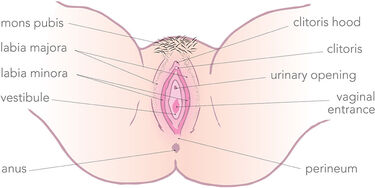A healthy sex life is an important part of your overall physical and mental health throughout your life. Learn more about sexual pleasure and different ways to have an enjoyable sex life.
It’s important to understand your genitals and how they work. The below picture shows the visible parts of the female genitals, including:

Some people think the vulva is the vagina, but they are different. Your vulva is the external part of the female genitals that you can see. Your vagina is inside your body. It extends from your vulva to the start of your uterus. It’s where your period blood comes out, where you can have sexual penetration and where babies pass through during childbirth.
It’s a good idea to see what your vulva looks like. You can use a mirror to see what is normal for you. And remember, every vulva is unique.
Check out the Labia Library online resource to see realistic images of female genitals.
Read more about the vulva and vagina.
Sexual pleasure is an important part of your sexual health and wellbeing.
There are lots of physical and emotional health benefits associated with sexual pleasure, including improved blood pressure and cardiovascular health for women, lowered stress, and improved sleep.
Sexual pleasure is something you can enjoy by yourself (masturbation) or with other people.
The tip of the clitoris is located towards the top of the vulva, where the inner labia meet. This is the most sensitive part of your body and its sole purpose is to provide pleasure. When your clitoris is touched, it can make you feel sexually aroused.
Clitoral stimulation can happen in different ways. For example, with fingers, oral sex, a sex toy or your partner’s genitals. The clitoris can also be stimulated through your vaginal wall during penetration.
Most women need clitoral stimulation to have an orgasm.
Other parts of your vulva can also be stimulated by touch. For example, the inner lips of your vulva.
You may have heard of the ‘G-spot’ – a mysterious spot in the vagina that brings a woman to climax. This area is actually a ‘clitoral cluster’ or an area of spongy tissue at the base of the clitoris that surrounds the urethra. This area fills with blood when you’re aroused. When it’s stimulated with a finger (used in a ‘come here’ finger curl) it may build sexual arousal.
The anus is another very sensitive part of the body. People of different sexual orientations may enjoy anal sex, for example, heterosexual and gay people. Anal sex can involve touching, licking or penetrating the anus. It’s important to use lubrication with anal sex as the anus doesn’t create its own lubrication.
It’s worth noting that some people don’t enjoy anal sex. You can say ‘no’ to anal sex even if you initially agreed to give it a go.
Erogenous zones are points on the body you can touch to stimulate pleasure. Everyone gets excited in different ways. Here are some pleasure points that may increase your sexual arousal:
You may also feel aroused when touched or kissed on:
You can touch parts of your body such as your vulva, clitoris or breasts, to get sexual pleasure. This is called ‘masturbation’. Masturbation is normal for people of any age. It can help you learn what feels good for you and what helps you orgasm so you can tell your partner. It’s also a way to get sexual pleasure if you don’t have a partner.
It’s normal to masturbate from a few times a day to a few times a month. It’s also okay if you don’t masturbate.
You can use sex toys to give yourself and others sexual pleasure. They can help you learn about your body and what satisfies you sexually. They can also make sex more fun!
Sex toys come in different shapes, sizes and colours. There’s something to meet everyone’s needs, including toys designed for people with disabilities. Different toys can be used to stimulate different parts of your body. For example, your vagina, clitoris or anus.
Many sex toys are made from silicone, which is non-toxic, soft, flexible and unlikely to cause allergic reactions. Buy sex toys from reputable suppliers to ensure they’re safe.
When using sex toys:
There are lots of ways to engage in sexual intimacy and pleasure. If you aren’t satisfied with your sex life or you find it hard to experience sexual pleasure, a sex therapist or sexologist can help.
This content has been reviewed by a group of medical subject matter experts, including Sexual Health Victoria.
© Jean Hailes Foundation. All rights reserved.